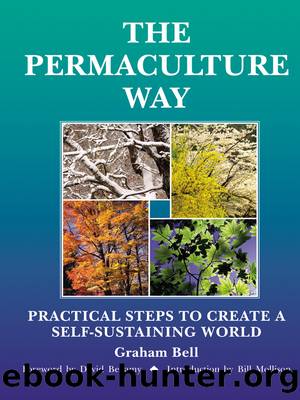The Permaculture Way by Graham Bell

Author:Graham Bell
Language: eng
Format: epub
Tags: ebook, book
Publisher: Chelsea Green Publishing
Published: 2011-02-26T16:00:00+00:00
Lastly, as anyone can testify who has experienced true wilderness, these areas of the planet are sacred for their beauty and abundance alone. How could anyone who had destroyed a rainforest, or a wild oak wood, a penguin colony or a dolphin habitat sleep easy at night? Yet unless we protect existing wilderness, and set aside space for the regeneration of new ones, then we are all party to this kind of destruction.
Regeneration Techniques
As there is precious little wilderness remaining, then we need to make more. We may never know the full reasons why, precisely because they are an investment for the future. Once we have killed the last living thing, how then will we live? This principle insists that we help regenerate what we have over-culled.
The best and most effective technique for regenerating wilderness is to do nothing. If we plant or plan a wilderness, then it is not wild, it is a plantation. We do, however, need to protect the space. This means fencing, either physically, or metaphorically. In Britain and North Africa the great destroyers of forest, the people, brought in sheep and goats in vast numbers to achieve the destruction. The wealth of Britain is so founded on this cycle of destruction that the Speaker of the House of Commons still sits, ceremonially, on The Woolsack. The wonder-beast of the Middle Ages, with its yield of meat, milk and fibre, has denuded many a landscape of trees.
Other predators to exclude are rabbits, deer, people, and pollution. The natural cycle of any environment is always one of succession. If unhindered nature will colonise even the most marginal area, and in time build fertile systems. For instance, into the bare moorland comes bracken, which draws potassium from the subsoil, and in dying, automatically mulches the ground to protect against erosion. Depleted bare soils are its niche, and there it thrives.
By simply protecting moorland which has gone to bracken, gorse and broom will appear, or on very wet ground bog myrtle. These are nitrogen-fixing plants, and need potassium before they can establish. They succeed bracken, flourishing to leave a richer soil. Gorse will spread outwards, dying at its heart, and into this space in the enriched soil, rowan and birch will seed. They are edge trees and will gradually build scrub woodland. In time they will give way to climax trees, oak, pine and ash in particular.
Download
This site does not store any files on its server. We only index and link to content provided by other sites. Please contact the content providers to delete copyright contents if any and email us, we'll remove relevant links or contents immediately.
| Colder Climates | Desert |
| Temperate | Tropical |
Turbulence by E. J. Noyes(7059)
The Thirst by Nesbo Jo(5795)
Gerald's Game by Stephen King(3928)
Be in a Treehouse by Pete Nelson(3234)
Marijuana Grower's Handbook by Ed Rosenthal(3126)
The Sprouting Book by Ann Wigmore(3057)
The Red Files by Lee Winter(2923)
The Remains of the Day by Kazuo Ishiguro(2627)
Sharp Objects: A Novel by Gillian Flynn(2452)
Christian (The Protectors Book 1) by L. Ann Marie(2396)
Organic Mushroom Farming and Mycoremediation by Tradd Cotter(2314)
The Culinary Herbal by Susan Belsinger(2063)
Stone Building by Kevin Gardner(1998)
The Starter Garden Handbook by Alice Mary Alvrez(1930)
Lilac Girls by Martha Hall Kelly(1883)
The Unlikely Pilgrimage of Harold Fry by Rachel Joyce(1838)
The Lean Farm Guide to Growing Vegetables: More In-Depth Lean Techniques for Efficient Organic Production by Ben Hartman(1789)
Urban Farming by Thomas Fox(1752)
Backyard Woodland by Josh VanBrakle(1591)
